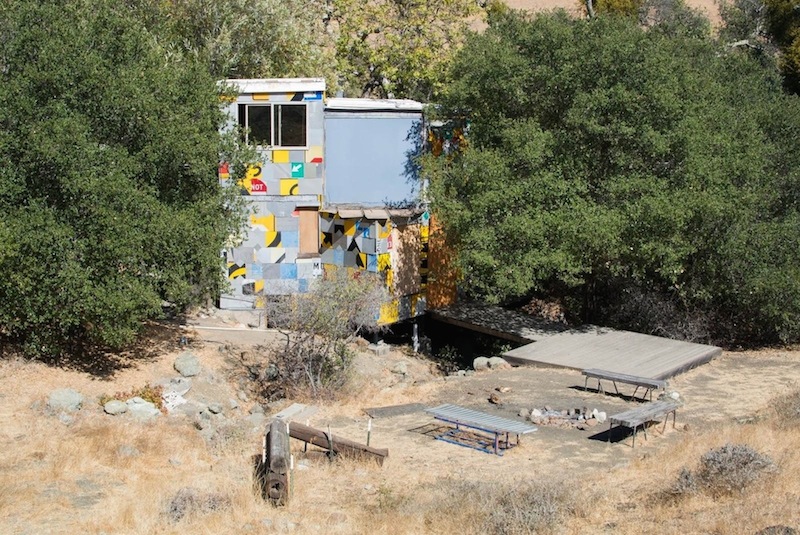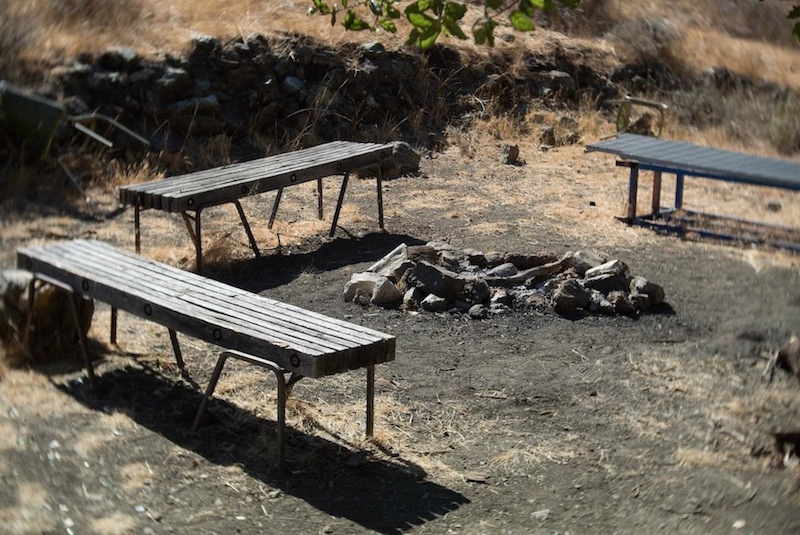Grand canyon: Cal Poly bands together to save Poly Canyon
Story highlights:
- The architecture projects in Poly Canyon have suffered vandalism and neglect.
- A group of Cal Poly students, administrators and alumni are working to organize Canyon Days, where projects to renovate them will be undertaken.
- Canyon Days is tentatively set to take place the third weekend of Winter Quarter 2015.
- The College of Architecture and Environmental Design would like to maintain the canyon going forward, and perhaps even build new projects.
CLEVER SOLUTIONS
The task was removing SUV sized boulders from a soccer field in Kenya.
“We unearthed it, and it just kept getting bigger and bigger and bigger,” Cal Poly alum Lucas Hogan said.
Hogan was an architectural engineering student at the time, and was working on construction in a village for HIV-positive people in Kenya, as a project during his final quarter at school.
One of the local men said the solution to the problem was simple. All they needed to do was start a fire on the boulder, let it heat, and then pour cool water over it. The sudden change in temperature would cause the rock to crack, and then it could be removed by hand and with sledgehammers.
In Kenya, Hogan had to be flexible in the way he tackled problems. There was a sense of being on your own, and needing to rely on what you had at hand to get things done, he said.
When looking back on the experience, Hogan said it was reminiscent of the spirit of his time living and working as a caretaker in Poly Canyon, while a student at Cal Poly.
Poly Canyon is the home of projects built by Cal Poly students working in architecture and related disciplines. The projects are ambitious full-size structures ranging from a spindly flower-like sculpture made of reinforced concrete, to a house with a gently sloping roof that seems to flow towards its edges. They have been built throughout the decades, going back to the early 1960s.
As a caretaker, Hogan lived in Poly Canyon in the Modular House, an experimental house built in the 1960s and early 1970s. Visitors may recognize it by its distinctive road-sign covered outer wall.
Hogan was responsible for performing basic maintenance to the structures, such as painting over graffiti, trimming plants back for fire protection, as well as asking visitors to leave the canyon after dark.
Though the specifics of working in Kenya and the canyon were not the same, the feeling of being on your own and having to be flexible and clever with your resources were analogous, Hogan said.
Now working as a postdoctoral earthquake researcher at the University of Auckland in New Zealand, Hogan said the time he spent living in Poly Canyon was important to his personal development.
“It prepares you well for lateral thinking,” Hogan said.
TARNISHED HOME
 Hogan lived in the Modular House
Hogan lived in the Modular House
Its been several years since a caretaker lived in Poly Canyon. Hogan has made a trip back to the canyon every year since he graduated, while on the way to visit his parents in Ohio. On a recent visit, he noticed a change that troubled him.
Graffiti and vandalism in the canyon had increased. Though there had always been some, this time it was worse.
Hogan wasn’t the only person who noticed the increase in vandalism in Poly Canyon. Kevin Dong, Associate Dean of Administration in the College of Architecture and Environmental Design (CAED), said he has seen an increase in the last year.
Now, something is being done to reverse this trend.
In response to the disrepair in the canyon, a group of students, alumni, and administrators are banding together to create an event they’re calling Canyon Days, where volunteers will work on projects to fix up the structures in the canyon. Whether it was learning a sense of independence, or the triumph of constructing an original structure, those working to rehabilitate the canyon feel an emotional connection, based on memories big and small.
For the Canyon Days volunteers, Poly Canyon is a place worth saving. The canyon is valuable because it is a great place for experiential learning, and it goes hand-in-hand with Cal Poly’s “Learn by Doing” approach, Dong said.
He also sees it as a great place for the university to continue to try progressive ideas in building responsibly and sustainably.
It’s also a unique resource - Dong couldn’t recall any other university that had a similar facility on such a large scale.
THE PLAN
Impetus for the project came together at an opportune time, Dong said. Dong was surveying the structures in the canyon, and compiling a list of needed repairs when Hogan pitched the Canyon Days idea.
Hogan envisioned a work-day in the canyon, where current students, alumni and more would work on projects during the day, have dinner together in the canyon, and perhaps even spend the night under the stars.
Now that the Canyon Days idea is under way, hammering out the reality of Hogan’s vision is the next step.
The event is being organized by a group of student volunteers, in collaboration with Dong.
Projects on the table for Canyon Days include:
- Painting over graffiti
- Re-tensioning or replacing cables
- Repairing guardrails
- Replacing decking
- Removing panels to make structures more open, so people can’t gather away from view at night
- Removing the interior of the Shell House
Making the structures safe is the priority of the renovations, Dong said.
There has been discussion about taking some of the structures down. Dong said the college would like to avoid this if possible, and would only take a structure apart if it cannot be made safe.
The student organizing committee had its second meeting the Thursday before Thanksgiving, where they discussed logistics for the event.
Inviting volunteers to camp-out in the canyon after the work day was quickly nixed. The event is tentatively slated to take place on Jan. 24. It was decided it would be too cold to comfortably spend the night.
The Canyon Days committee is working on a tight schedule, and still needs to decide a number of things:
- Whether the general public can volunteer, or just College of Architecture and Environmental Design students and alumni
- How to promote the event
- Whether a band will perform
- Whether to host history tours of the canyon for the public
The group had broken up into subcommittees by the end of the meeting, and each began planning how to accomplish their portion of the event.
Nicole O’Hearne, an architectural engineering senior and president of the Cal Poly chapter of the Structural Engineers Association of California, is heading up the Canyon Days committee. O’Hearne went on a tour of Poly Canyon in her freshman year, and has been interested in it ever since.
“I thought it was super interesting, so now whenever I’m going out there, I’m telling everyone the history of the structures, I find it really fun,” O’Hearne said.
A NEW DESIGN VILLAGE
Like many of those now working to maintain the canyon, she has fond memories of her time there, and particularly of Design Village, the yearly architecture event held in the canyon that draws national attention and participation.
During Design Village, freshman in the College of Architecture and Environmental Design are required to build a structure on campus, disassemble it, carry it on foot into Poly Canyon, set it back up again, and then spend the night in their creation.
For her project, O’Hearne’s group built a “tripod-esque” structure, that featured a table and three spaces for beds. Their structure was light enough to be moved all the way to the top of a hill in Poly Canyon, where they hoisted an American flag over it.
O’Hearne said the sense of community is what makes Design Village special.
“It was a good experience for most people, as long as your structure stood up,” she said.
Design Village was on Hogan’s mind when he came up with the idea for Canyon Days. He wants the two events to parallel each other.
Though Canyon Days will be in winter this year, the plan is to hold it in fall in the future. Canyon Days will be at the beginning of the year in fall, and Design Village is in the spring.
O’Hearne believes Canyon Days will capture the same sense of community that makes Design Village special, but with its own unique feel, due to the addition of alumni, and potentially attendees from the whole university.
LOOKING AHEAD
As for the larger future of the canyon, Dong said the College of Architecture and Environmental Design would like to maintain the space, and is open to allowing students to build projects there in the future. Dong said the main limiter on new projects in the canyon is the huge time and resource commitment required of students who want to complete a project there.
Any new constructions would likely be semi-permanent, though that hasn’t stopped them from standing the test of time before. Dong said most of the structures currently in the canyon were never intended to be permanent - familiarity and affection have kept them in place.
TAKE CARE
 Hogan enjoyed watching wildlife from his deck in the mornings.
Hogan enjoyed watching wildlife from his deck in the mornings.
The caretaker position Hogan held was cut when California State University funding was reduced in 2007 and 2008.
Dong said it was possible that the College of Architecture and Environmental Design would hire a caretaker again in the future, but maintenance needs to be completed first so the canyon is safe to live in.
Though another Cal Poly student won’t get to experience living in Poly Canyon in the near future, the Canyon Days committee hopes to see the canyon appreciated by students and the community - and to perhaps even shed its “graveyard” moniker.
Because Poly Canyon is a special place for many who’ve spent time there.
“It set me up well for my life since then,” Hogan said. “There’s an easy comfortable road, and there was a far more interesting and adventurous road to go down.”